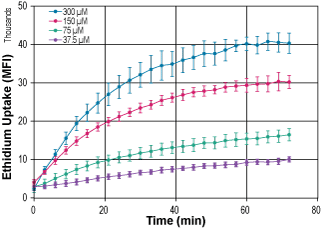Overview
Cat #:
A-385
Alternative Name BzATP, Benzoylbenzoyl-ATP, 2′(3′)-O-(4-Benzoylbenzoyl)adenosine 5′-triphosphate triethylammonium salt
Lyophilized Powder yes
Source Synthetic
MW: 1018.97
Purity: >95%
Effective concentration 0.5-300 µM.
Chemical name [(2R,3S,4R,5R)-5-(6-aminopurin-9-yl)-4-hydroxy-2-[[hydroxy-[hydroxy(phosphonooxy)phosphoryl]oxyphosphoryl]oxymethyl]oxolan-3-yl] 4-benzoylbenzoate;N,N-diethylethanamine.
Molecular formula C24H24N5O15P3 · C18H45N3.
CAS No.: 112898-15-4
PubChem CID 71308559
Activity BzATP triethylammonium salt is an agonist of the purinergic P2X7 receptor, more potent than ATP, with EC50 varying from 0.7 to 285 µM, depending on receptor species, buffer composition, serum constituents and repeated exposure to ATP. Shows partial agonist activity on other P2X receptors. Can be used as a photoaffinity label for ATPase1-3.
References-Activity
- Williams, N. and Coleman, P.S. (1982) J. Biol. Chem. 257, 2834.
- Zhong, Y. et al. (1998) Br. J. Pharmacol. 125, 771.
- Hibell, A.D. et al. (2000) Br. J. Pharmacol. 130, 167.
Shipping and storage Shipped at room temperature. Product as supplied can be stored intact at room temperature for several weeks. For longer periods, it should be stored at -20°C.
Solubility Soluble up to 100 mM in water. Centrifuge all products before handling (10000 x g 5 min).
Storage of solutions -20°C. It is recommended to aliquot stock solutions to prevent repeated thawing and freezing.
Our bioassay
 Alomone Labs BzATP triethylammonium salt activates human P2X7 receptors expressed in HEK-293 cells.Dose-response curve of hP2X7 activation by BzATP triethylammonium salt (#A-385). Cells were loaded with Fluo-8 NW dye and stimulated with increasing concentrations of BzATP triethylammonium salt. Changes in intracellular Ca2+ following agonist application were detected as changes in maximum relative fluorescence (RLU) using FLIPRTETRA™.
Alomone Labs BzATP triethylammonium salt activates human P2X7 receptors expressed in HEK-293 cells.Dose-response curve of hP2X7 activation by BzATP triethylammonium salt (#A-385). Cells were loaded with Fluo-8 NW dye and stimulated with increasing concentrations of BzATP triethylammonium salt. Changes in intracellular Ca2+ following agonist application were detected as changes in maximum relative fluorescence (RLU) using FLIPRTETRA™.
Scientific background
BzATP triethylammonium salt is an agonist of the purinergic P2X7 receptor that is ten times more potent than ATP1. On rat P2X7 receptor, BzATP triethylammonium salt demonstrates an EC50 value of 6.8 µM2. The compound also shows partial agonist activity on other P2X receptors1.
P2X receptors are a family of ion channels gated by ATP, a ligand that mediates numerous physiological functions. P2X receptors are widely localized in cell types of almost every origin, including neuronal, muscular, epithelial and immune, and have been shown to play a pivotal role in models of various pain conditions2.
Target P2X7 receptors
Lyophilized Powder
Image & Title 
Alomone Labs BzATP triethylammonium salt activates P2X7 receptors expressed in HEK-293 cells. Concentration-dependent activation of P2X7 receptors by BzATP triethylammonium salt (#A-385), determined by measuring ethidium-bromide (EtBr) uptake into HEK-293 cells expressing mP2X7R following agonist application. EtBr ion uptake is shown as changes in mean fluorescence intensity (MFI) over time, quantified using Tecan Spark® plate reader, with an excitation wavelength of 485 nm and emission wavelength of 620 nm.
Data was kindly provided by Dr. Miriam Ravins and Prof. Emanuel Hanski, Department of Microbiology and Molecular Genetics, Faculty of Medicine, The Hebrew University of Jerusalem, Israel.

Alomone Labs BzATP triethylammonium salt activates P2X7 receptors expressed in HEK-293 cells. Concentration-dependent activation of P2X7 receptors by BzATP triethylammonium salt (#A-385), determined by measuring ethidium-bromide (EtBr) uptake into HEK-293 cells expressing mP2X7R following agonist application. EtBr ion uptake is shown as changes in mean fluorescence intensity (MFI) over time, quantified using Tecan Spark® plate reader, with an excitation wavelength of 485 nm and emission wavelength of 620 nm.
Data was kindly provided by Dr. Miriam Ravins and Prof. Emanuel Hanski, Department of Microbiology and Molecular Genetics, Faculty of Medicine, The Hebrew University of Jerusalem, Israel.
For research purposes only, not for human use
Last Update: 16/03/2025
Specifications
Citations
Citations

